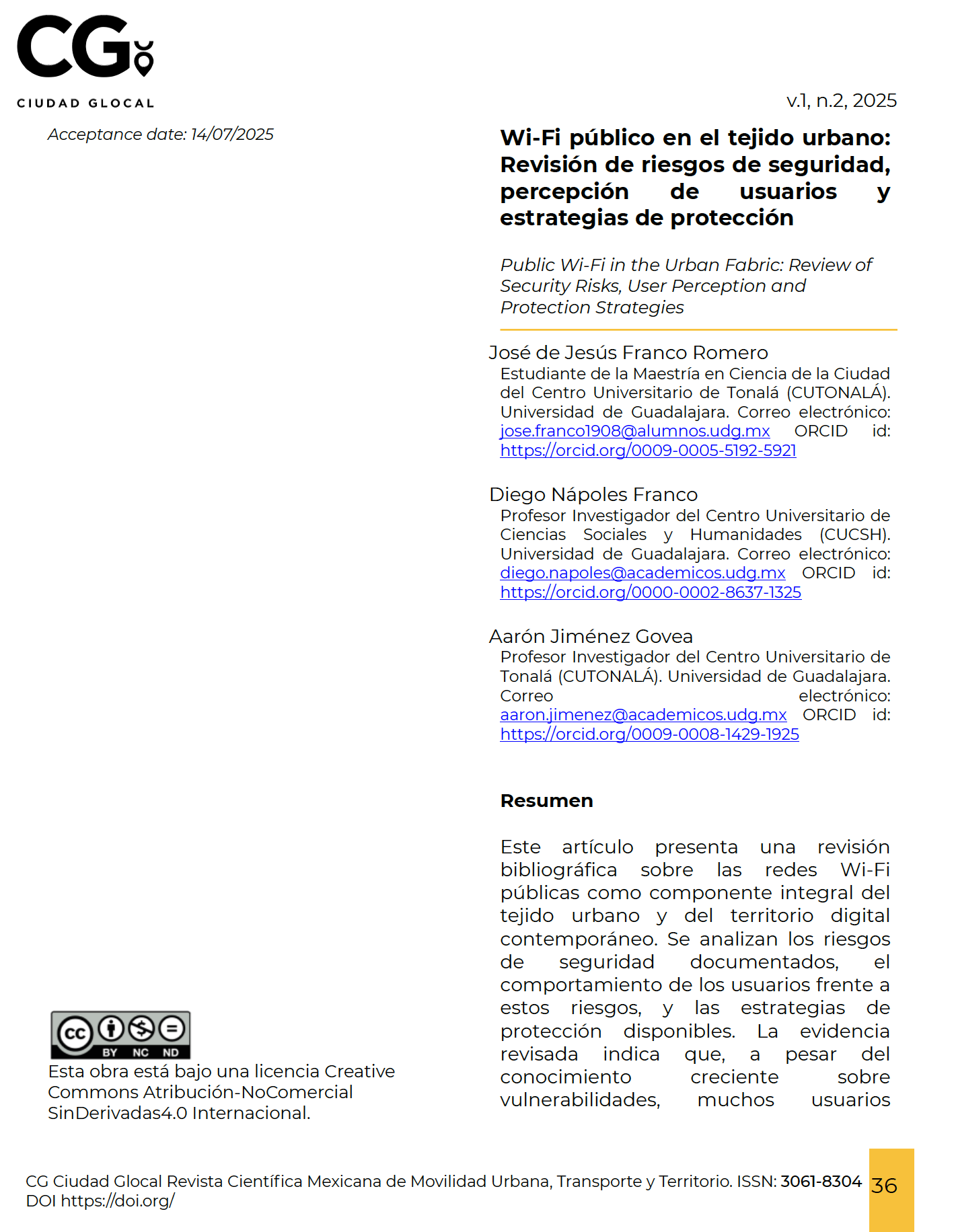Wi-Fi público en el tejido urbano: Revisión de riesgos de seguridad, percepción de usuarios y estrategias de protección
DOI:
https://doi.org/10.1234/yen12127Palabras clave:
Wi-Fi público, Seguridad cibernética, Tejido urbano, Comportamiento de usuarios, Heurística de preservación de recursos, Infraestructura digital, Movilidad digital, Territorio urbanoResumen
Este artículo presenta una revisión bibliográfica sobre las redes Wi-Fi públicas como componente integral del tejido urbano y del territorio digital contemporáneo. Se analizan los riesgos de seguridad documentados, el comportamiento de los usuarios frente a estos riesgos, y las estrategias de protección disponibles. La evidencia revisada indica que, a pesar del conocimiento creciente sobre vulnerabilidades, muchos usuarios continúan utilizando redes Wi-Fi públicas no seguras principalmente debido a la conservación de datos móviles y factores situacionales. Estudios experimentales en diversos contextos urbanos revelan la transmisión de información sensible sin cifrado adecuado, desde credenciales de inicio de sesión hasta datos personales identificables. La literatura también documenta cómo factores demográficos, ambientales y cognitivos influyen en las decisiones de los usuarios, destacando la “heurística de preservación de recursos”. Se subraya además la relación del Wi-Fi público con la movilidad urbana y la configuración del territorio digital, mostrando cómo la disponibilidad y seguridad de estas redes impactan la accesibilidad, interacción y equidad en el espacio urbano. Las conclusiones apuntan hacia estrategias multidisciplinarias que combinan soluciones técnicas, educación dirigida y políticas públicas, promoviendo ciudades conectadas de manera segura y equitativa.
Descargas
Referencias
Ali, S., Osman, T., Mannan, M., & Youssef, A. (2019). On privacy risks of public WiFi captive portals. En C. Pérez-Solà, G. Navarro-Arribas, A. Biryukov, & J. Garcia-Alfaro (Eds.), Data privacy management, cryptocurrencies and blockchain technology (pp. 80-98). Springer. https://doi.org/10.1007/978-3-030-31500-9_6
Bonné, B., Rovelo, G., Quax, P., & Lamotte, W. (2017). Insecure network, unknown connection: Understanding Wi-Fi privacy assumptions of mobile device users. Information, 8(3), 76. https://doi.org/10.3390/info8030076
Cheng, N., Oscar Wang, X., Cheng, W., Mohapatra, P., & Seneviratne, A. (2013). Characterizing privacy leakage of public WiFi networks for users on travel. 2013 Proceedings IEEE INFOCOM, 2769-2777. https://doi.org/10.1109/INFCOM.2013.6567086
Comisión Económica para América Latina y el Caribe. (2022). A digital path for sustainable development in Latin America and the Caribbean (LC/CMSI.8/3). Naciones Unidas.
De Santo, A., & Gaspoz, C. (2015). Influence of users' privacy risks literacy on the intention to install a mobile application. En A. Rocha, A. M. Correia, S. Costanzo, & L. P. Reis (Eds.), New contributions in information systems and technologies (pp. 329-341). Springer. https://doi.org/10.1007/978-3-319-16486-1_33
Diekert, F., & Brekke, K. A. (2022). Groups discipline resource use under scarcity. Theory and Decision, 92(1), 75-103. https://doi.org/10.1007/s11238-021-09813-4
Ferreira, A., Huynen, J.-L., Koenig, V., & Lenzini, G. (2014). Socio-technical security analysis of wireless hotspots. En T. Tryfonas & I. Askoxylakis (Eds.), Human aspects of information security, privacy, and trust (pp. 306-317). Springer. https://doi.org/10.1007/978-3-319-07620-1_27
Folta, S. C., Anyanwu, O., Pustz, J., Oslund, J., Penkert, L. P., & Wilson, N. (2022). Food choice with economic scarcity and time abundance: A qualitative study. Health Education & Behavior, 49(1), 150-158. https://doi.org/10.1177/10901981211045926
Janse Van Rensburg, W., Thomson, K.-L., & Futcher, L. (2018). Factors influencing smartphone application downloads. En L. Drevin & M. Theocharidou (Eds.), Information security education – towards a cybersecure society (pp. 81-92). Springer. https://doi.org/10.1007/978-3-319-99734-6_7
Kern, B. D. (2004). Whacking, joyriding and war-driving: Roaming use of Wi-Fi and the law. Santa Clara High Technology Law Journal, 21(1), 101-178. https://digitalcommons.law.scu.edu/chtlj/vol21/iss1/3
Lotfy, A. Y., Zaki, A. M., Abd-El-Hafeez, T., & Mahmoud, T. M. (2021). Privacy issues of public Wi-Fi networks. En A. E. Hassanien, A. Haqiq, P. J. Tonellato, L. Bellatreche, S. Goundar, A. T. Azar, E. Sabir, & D. Bouzidi (Eds.), Proceedings of the International Conference on Artificial Intelligence and Computer Vision (AICV2021) (pp. 656-665). Springer. https://doi.org/10.1007/978-3-030-76346-6_58
Lugovic, S., Mrsic, L., & Korona, L. Z. (2019). Public WiFi security network protocol practices in tourist destination. En C. Esposito, J. Hong, & K.-K. R. Choo (Eds.), Pervasive systems, algorithms and networks (pp. 321-332). Springer. https://doi.org/10.1007/978-3-030-30143-9_27
Lv, X., Wang, X., & Fu, X. (2014). Why poverty impedes decision performance? Three psychological explanations. Advances in Psychological Science, 22(11), 1823. https://doi.org/10.3724/SP.J.1042.2014.01823
Maimon, D., Howell, C. J., Jacques, S., & Perkins, R. C. (2020). Situational awareness and public Wi-Fi users' self-protective behaviors. Security Journal, 35, 154-174. https://doi.org/10.1057/s41284-020-00270-2
McShane, I., Gregory, M. A., & Wilson, C. (2016). Practicing safe public Wi-Fi: Assessing and managing data-security risks. SSRN Electronic Journal. https://doi.org/10.2139/ssrn.2895216
Ndibwile, J. D., Luhanga, E. T., Fall, D., Miyamoto, D., & Kadobayashi, Y. (2018). A comparative study of smartphone-user security perception and preference towards redesigned security notifications. Proceedings of the Second African Conference for Human Computer Interaction: Thriving Communities, 1-6. https://doi.org/10.1145/3283458.3283486
Ndibwile, J. D., Luhanga, E., Fall, D., & Kadobayashi, Y. (2019). A demographic perspective of smartphone security and its redesigned notifications. J. Inf. Process., 27, 773-786. https://doi.org/10.2197/ipsjjip.27.773
Ndibwile, J. D., Luhanga, E. T., Fall, D., Miyamoto, D., & Kadobayashi, Y. (2018). Smart4Gap: Factors that influence smartphone security decisions in developing and developed countries. Proceedings of the 2018 10th International Conference on Information Management and Engineering, 5-15. https://doi.org/10.1145/3285957.3285980
Sangeen, M., Bhatti, N. A., Kifayat, K., Alsadhan, A. A., & Wang, H. (2023). Blind-trust: Raising awareness of the dangers of using unsecured public Wi-Fi networks. Computer Communications, 209, 359-367. https://doi.org/10.1016/j.comcom.2023.07.011
Sombatruang, N., Kadobayashi, Y., Sasse, M. A., Baddeley, M., & Miyamoto, D. (2018). The continued risks of unsecured public Wi-Fi and why users keep using it: Evidence from Japan. 2018 16th Annual Conference on Privacy, Security and Trust (PST), 1-11. https://doi.org/10.1109/PST.2018.8514208
Sombatruang, N., Onwuzurike, L., Sasse, M. A., & Baddeley, M. (2019). Factors influencing users to use unsecured wi-fi networks: Evidence in the wild. Proceedings of the 12th Conference on Security and Privacy in Wireless and Mobile Networks, 203-213. https://doi.org/10.1145/3317549.3323412
Sombatruang, N., Sasse, M. A., & Baddeley, M. (2016). Why do people use unsecure public wi-fi?: An investigation of behaviour and factors driving decisions. Proceedings of the 6th Workshop on Socio-Technical Aspects in Security and Trust, 61-72. https://doi.org/10.1145/3046055.3046058
Soon, J.-J., Abdul Adzis, A., Applanaidu, S. D., & Zainal Abidin, N. (2024). Food expenditure of the poorest deciles: Expected vulnerability and counterintuitive indulgence? Journal of the Asia Pacific Economy, 29(3), 1239-1256. https://doi.org/10.1080/13547860.2023.2166718
Swanson, C., Urner, R., & Lank, E. (2010). Naïve security in a Wi-Fi world. En M. Nishigaki, A. Jøsang, Y. Murayama, & S. Marsh (Eds.), Trust management IV (pp. 32-47). Springer. https://doi.org/10.1007/978-3-642-13446-3_3
Szewczyk, P., & Macdonald, R. (2017). Broadband router security: History, challenges and future implications. The Journal of Digital Forensics, Security and Law. https://doi.org/10.15394/jdfsl.2017.1444
Szongott, C., Brenner, M., & Smith, M. (2015). METDS - a self-contained, context-based detection system for evil twin access points. En R. Böhme & T. Okamoto (Eds.), Financial cryptography and data security (pp. 370-386). Springer. https://doi.org/10.1007/978-3-662-47854-7_22
UN-Habitat. (2021). Assessing the digital divide: Understanding internet connectivity and digital literacy in cities and communities. United Nations Human Settlements Programme.
Zhang, X. J., Li, Z., & Deng, H. (2017). Information security behaviors of smartphone users in China: An empirical analysis. The Electronic Library, 35(6), 1177-1190. https://doi.org/10.1108/EL-09-2016-0183

Publicado
Número
Sección
Licencia
Derechos de autor 2025 CG Ciudad Glocal Revista Científica Mexicana de Movilidad Urbana, Transporte y Territorio

Esta obra está bajo una licencia internacional Creative Commons Atribución-NoComercial-SinDerivadas 4.0.












